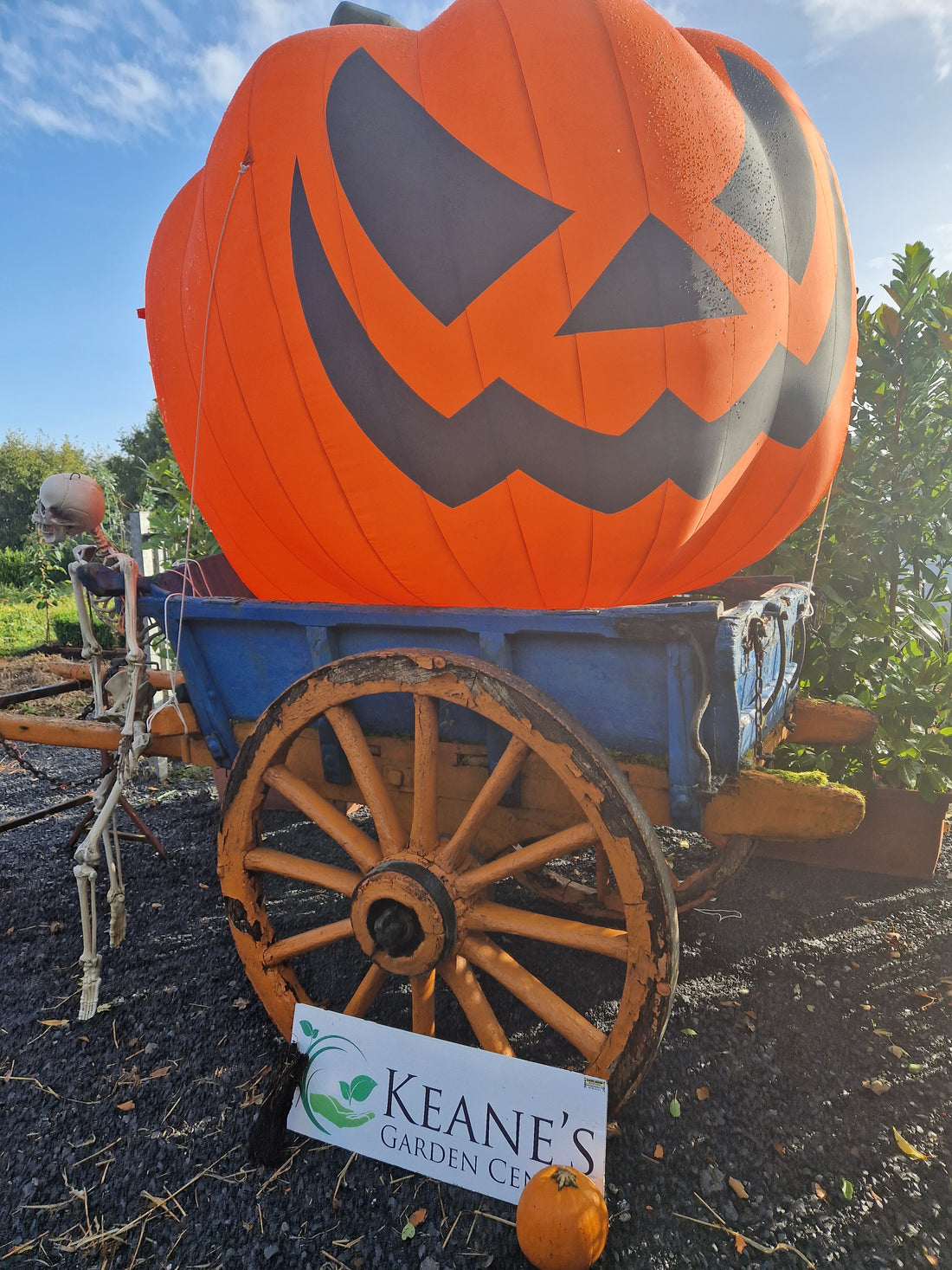In recent years picking your own Pumpkins from local Pumpkin patches has become increasingly popular - at Keanes we’ve been growing our own Pumpkins for a number of years now with a great reputation for big, quality Pumpkins, and this year we have a bumper crop of big orange Pumpkins ideal for carving and decorating. We get a great kick out of watching the children discover the Pumpkin Patch and eagerly try to find their favourite Pumpkin amongst all the Halloween props and scary decorations. This year we’ve grown our biggest Pumpkin ever - a massive, hard to lift giant of a Pumpkin - on display inside the shop - it’s a whopper! Pumpkins are sometimes mistaken for a vegetable but they’re technically a fruit - like tomatoes and cucumbers the fruits emerge from a flower and will contain up to 500 seeds. We plant our Pumpkins at the end of May or early June - mostly outdoors in the nursery and a small amount in some of our polytunnels - that’s where the giant one came from, and they start to ripen from around mid September/early October onwards. Pumpkins are full of vitamins and each part of the Pumpkin is edible including the flowers which can be deep fried in batter or you can use the flesh to make delicious Pumpkin soup, Pumpkin curry or roasted Pumpkin seeds or perhaps some good old American Pumpkin pie!
Pumpkins are native to Central America and Mexico. Scientists believe that Pumpkins originated about 9000 years ago. The oldest Pumpkin seeds have been found in Mexico and date back to somewhere between 7000-5550 B.C.. Pumpkins were a historically important food staple among Native Americans along with corn and beans.
To grow Pumpkins you can start from seed indoors, but can also be sown later outdoors in a sheltered spot. Starting them off in small 3 inch pots indoors around the end of April, this will help give you an earlier crop, sow them about a half an inch deep and keep them at room temperature. You can usually buy small pumpkin plants for growing on in garden centres in late Spring. You can also sow seeds directly in the ground where you want them to grow, sowing about an inch deep around the middle of May.
Pumpkins need a nice sunny location sheltered from cold winds and with nice moist, rich soil. If you’ve started plants inside you can plant them out around the end of May when the risk of frost has passed. Plant them with plenty of multipurpose compost and feed them with a good slow release fertilizer - Osmo pro bloom or Vitax Q4 are both ideal - and give them plenty of space 5 or 6 feet apart. You can grow them in containers or grow bags but remember they’re a thirsty plant and will need plenty of regular watering. During the Summer months feed them every 2 weeks with a high potash liquid feed - tomato feed or Nutri one would be perfect for this. Once the fruits start to develop you can place a tile or small piece of timber underneath to keep them off the wet soil. Once they get a good colour you can start to harvest them - usually around the end of September or mid October and they can be used straight away or stored for later use. If you’re keeping them for later, place the Pumpkins in the sun for a week, either outdoors or in a greenhouse, to harden (or cure) the skins. This helps to ensure they keep well. You can keep them in a well ventilated area indoors around 10 or 15 degrees and they should hold for around 3 or 4 months.
The tradition of carving Pumpkins originated in Ireland but Turnips or Beets were originally used - scary faces were carved into them and were used to frighten away evil spirits and unwelcome visitors - and when Irish people emigrated to America they found continuing the tradition somewhat easier using Pumpkins rather than Turnips and carved Pumpkins have become a staple Halloween traditional decoration ever since.
To help preserve your Pumpkin after carving there’s a few tricks of the trade - spraying the inside with hairspray or spray with water that has a few drops of bleach to help prevent bacteria - sometimes vinegar is used for the same antibacterial properties. You can also rub the carved flesh with vaseline to help preserve the moisture - keeping them cool and out of direct sunlight will also help them last longer and you can rub vegetable or olive oil on the outside and inside to help them last longer.
So, next year you’ll be all set to grow your own but for this year if you want to call to the garden centre we'll have any amount of Pumpkins to choose from in the Pumpkin Patch and we’ll have face painting & treasure hunts and loads of photo opportunities during the week and at the weekends leading up to Halloween and plenty of Halloween surprises !!!
A Few Jobs For The Week Ahead;
- Plant some indoor, scented bulbs like Paperwhite Narcissus and prepared Hyacinths for beautiful fragrance around Christmas.
- Reduce the height of Roses to help prevent wind rock in the windy Winter conditions.
- Plant up pots and window boxes with some cheerful Violas or Pansies adding some Cyclamen, Heathers and small Skimmias
- Set your lawn up for the Winter with some Autumn Lawn Feed and consider scarifying and aerating the lawn
- Top up your Bird Feeders as the cold weather approaches the birds will appreciate a bit of a helping hand

